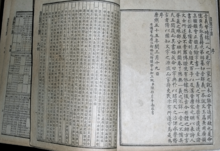Kangxi Dictionary
| Kangxi Dictionary | |||||||||||||||||||
|---|---|---|---|---|---|---|---|---|---|---|---|---|---|---|---|---|---|---|---|
 The Kangxi Dictionary: 2005 reprint | |||||||||||||||||||
 | |||||||||||||||||||
| Chinese name | |||||||||||||||||||
| Chinese | 康熙字典 | ||||||||||||||||||
| |||||||||||||||||||
| Japanese name | |||||||||||||||||||
| Kanji | 康熙字典 | ||||||||||||||||||
| Hiragana | こうきじてん | ||||||||||||||||||
| |||||||||||||||||||
Template:Contains Chinese text
The Kangxi Dictionary (Chinese: 康熙字典; pinyin: Kāngxī Zìdiǎn) was the standard Chinese dictionary during the 18th and 19th centuries. The Kangxi Emperor of the Manchu Qing Dynasty ordered its compilation in 1710. The creator innovated greatly by reusing and confirming the new Zihui system of 214 radicals, since then known as 214 Kangxi radicals, and was eventually published in 1716. The dictionary is named after the Emperor's era name.
The dictionary contains more than 47,000 characters (including obscure, variant, rare, and archaic characters) but less than a quarter of these characters are now in common use.
Compilation
The Kangxi Dictionary editors, including Zhang Yushu (張玉書) and Chen Tingjing (陳廷敬), based it partly on two Ming Dynasty dictionaries: the 1615 Zihui (字彙 "Character Collection") by Mei Yingzuo (梅膺祚), and the 1627 Zhengzitong (正字通 "Correct Character Mastery") by Zhang Zilie (張自烈). Since the imperial edict required that the Kangxi Dictionary be compiled within five years, a number of errors were inevitable. The Daoguang Emperor established a review board and their 1831 Zidian kaozheng (字典考證 "Character Dictionary Textual Research") corrected 2,588 mistakes, mostly in quotations and citations. (Teng and Biggerstaff 1971:130)
The supplemented dictionary contains 47,035 character entries, plus 1,995 graphic variants, giving a total of 49,030 different characters. They are grouped under the 596 radicals and arranged by the number of additional strokes in the character. Although these 596 radicals were first used in the Zihui, due to the popularity of the Kangxi Dictionary they are known as Kangxi radicals and remain in modern usage as a method to categorize traditional Chinese characters.
The character entries give variants (if any), pronunciations in traditional fanqie spelling and in modern reading of a homophone, different meanings, and quotations from Chinese books and lexicons. The dictionary also contains rime tables with characters ordered under syllable rime classes, tones, and initial syllable onsets.
The Kangxi Dictionary is available in many forms, from old Qing Dynasty editions in block printing, to reprints in traditional Chinese bookbinding, to modern revised editions with essays in Western-style hardcover, to the digitized Internet version.
The Kangxi Dictionary is one of the Chinese dictionaries used by the Ideographic Rapporteur Group for the Unicode standard.
Structure of the Kangxi dictionary
- Preface by Kangxi Emperor : pp. 1–6 (御製序)
- Notes on the use of the dictionary : pp. 7–12 (凡例)
- Indication of pronunciation of characters : pp. 13–40 (等韻)
- Comprehensive table of contents by radicals : pp. 41–49 (總目)
- Facilitated consulting contents : pp. 50–71 (检字)
- The dictionary proper : pp. 75–1631
- Main text : pp. 75–1538
- Addendum contents : pp. 1539–1544 (補遺)
- Addendum text : pp. 1545–1576
- Appendix contents (No–source–characters) : pp. 1577–1583 (備考)
- Appendix text : pp. 1585–1631
- Postscript : pp. 1633–1635 (後記)
- Textual research : pp. 1637–1683 (考证)
See also
- Dai Kan-Wa jiten
- Han-Han Dae Sajeon
- Hanyu Da Zidian
- List of Kangxi radicals
- Peiwen Yunfu
- Zhonghua Da Zidian
References
- Teng, Ssu-yü and Biggerstaff, Knight. 1971. An Annotated Bibliography of Selected Chinese Reference Works, 3rd ed. Cambridge, Mass: Harvard University Press. ISBN 0-674-03851-7
- Kangxi (Emperor of China) (1842). Chinese and English dictionary: containing all the words in the Chinese imperial dictionary; arranged according to the radicals, Volume 1. Printed at Parapattan. Retrieved 2011-05-15.
External links
- Kangxi Zidian (Tongwen Shuju edition), with dictionary lookup – Chinese Text Project
- Kangxi (Emperor of China) (1842). Chinese and English dictionary: containing all the words in the Chinese imperial dictionary; arranged according to the radicals, Volume 1. Printed at Parapattan. Retrieved 2011-05-15.
- 康熙字典網上版 Kangxi Dictionary Net Version
- Kangxi zidian 康熙字典, English translation of one definition, on Chinaknowledge.de
- Making Friends with the Kangxi zidian 康熙字典, Occasional paper with translation of Kangxi Emperor's preface 御製康熙字典序
- 汉典 The Chinese Language Dictionary Homepage (in Chinese only)
